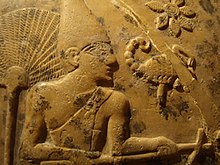
North Africa is a region encompassing the northern portion of the African continent. There is no singularly accepted scope for the region, and it is sometimes defined as stretching from the Atlantic shores of the Western Sahara in the west, to Egypt and Sudan's Red Sea coast in the east.
The 2nd millennium BC spanned the years 2000 BC to 1001 BC. In the Ancient Near East, it marks the transition from the Middle to the Late Bronze Age. The Ancient Near Eastern cultures are well within the historical era: The first half of the millennium is dominated by the Middle Kingdom of Egypt and Babylonia. The alphabet develops. At the center of the millennium, a new order emerges with Mycenaean Greek dominance of the Aegean and the rise of the Hittite Empire. The end of the millennium sees the Bronze Age collapse and the transition to the Iron Age.

The Sahara is a desert spanning across North Africa. With an area of 9,200,000 square kilometres (3,600,000 sq mi), it is the largest hot desert in the world and the third-largest desert overall, smaller only than the deserts of Antarctica and the northern Arctic.

Prehistoric Egypt and Predynastic Egypt is the period of time starting at the first human settlement and ending at the First Dynasty of Egypt around 3100 BC.

The history of North Africa has been divided into its prehistory, its classical period, the arrival and spread of Islam, the colonial period, and finally the post-independence era, in which the current nations were formed. The region has been influenced by many diverse cultures. The development of sea travel firmly brought the region into the Mediterranean world, especially during the classical period. In the 1st millennium AD, the Sahara became an equally important area for trade as camel caravans brought goods and people from the south of the Sahara. The region also has a small but crucial land link to the Middle East, and that area has also played a key role in the history of North Africa.
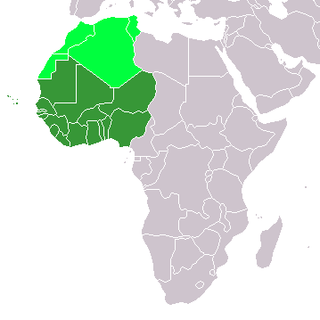
The History of West Africa has been divided into its prehistory, the Iron Age in Africa, the period of major polities flourishing, the colonial period, and finally the post-independence era, in which the current nations were formed. West Africa is west of an imagined north–south axis lying close to 10° east longitude, bordered by the Atlantic Ocean and Sahara Desert. Colonial boundaries are reflected in the modern boundaries between contemporary West African states, cutting across ethnic and cultural lines, often dividing single ethnic groups between two or more states.
Lactase persistence is the continued activity of the lactase enzyme in adulthood, allowing the digestion of lactose in milk. In most mammals, the activity of the enzyme is dramatically reduced after weaning. In some human populations though, lactase persistence has recently evolved as an adaptation to the consumption of nonhuman milk and dairy products beyond infancy. Lactase persistence is very high among northern Europeans, especially Irish people. Worldwide, most people are lactase non-persistent, and are affected by varying degrees of lactose intolerance as adults. However, lactase persistence and lactose intolerance can overlap.
Uan Muhuggiag is an archaeological site in Libya that was occupied by pastoralists between the early Holocene and mid-Holocene; the Tashwinat mummy, which was found at Uan Muhuggiag, was dated to 5600 BP and presently resides in the Assaraya Alhamra Museum in Tripoli.

Prehistory, also called pre-literary history, is the period of human history between the first known use of stone tools by hominins c. 3.3 million years ago and the beginning of recorded history with the invention of writing systems. The use of symbols, marks, and images appears very early among humans, but the earliest known writing systems appeared c. 5,200 years ago. It took thousands of years for writing systems to be widely adopted, with writing spreading to almost all cultures by the 19th century. The end of prehistory therefore came at different times in different places, and the term is less often used in discussing societies where prehistory ended relatively recently.

Bubalus, Bubaline, or Large Wild Fauna rock art is the earliest form of Central Saharan rock art, created in an engraved style, which have been dated between 12,000 BCE and 8000 BCE. The Bubaline Period is followed by the Kel Essuf Period. As the animal world is particularly emphasized in Bubaline rock art, animal depictions are usually shown in larger scale than human depictions. Bubaline rock art portrays a few geometric designs and naturalistic outlined depictions of animals, such as antelope, aurochs, buffalos, donkeys, elephants, fish, giraffes, hippopotamuses, ostriches, and rhinoceroses.

Egypt has a long and involved demographic history. This is partly due to the territory's geographical location at the crossroads of several major cultural areas: North Africa, the Middle East, the Mediterranean and Sub-Saharan Africa. In addition, Egypt has experienced several invasions and being part of many regional empires during its long history, including by the Canaanites, the Ancient Libyans, the Assyrians, the Kushites, the Persians, the Greeks, the Romans, and the Arabs.
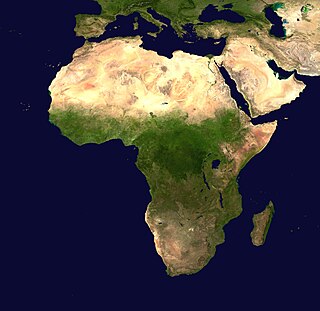
The Pastoral Neolithic refers to a period in Africa's prehistory, specifically Tanzania and Kenya, marking the beginning of food production, livestock domestication, and pottery use in the region following the Later Stone Age. The exact dates of this time period remain inexact, but early Pastoral Neolithic sites support the beginning of herding by 5000 BP. In contrast to the Neolithic in other parts of the world, which saw the development of farming societies, the first form of African food production was nomadic pastoralism, or ways of life centered on the herding and management of livestock. The shift from hunting to food production relied on livestock that had been domesticated outside of East Africa, especially North Africa. This period marks the emergence of the forms of pastoralism that are still present. The reliance on livestock herding marks the deviation from hunting-gathering but precedes major agricultural development. The exact movement tendencies of Neolithic pastoralists are not completely understood.

The genetic history of Africa summarizes the genetic makeup and population history of African populations in Africa, composed of the overall genetic history, including the regional genetic histories of North Africa, West Africa, East Africa, Central Africa, and Southern Africa, as well as the recent origin of modern humans in Africa. The Sahara served as a trans-regional passageway and place of dwelling for people in Africa during various humid phases and periods throughout the history of Africa.
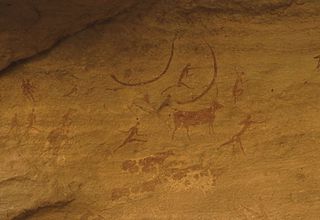
Pastoral rock art is the most common form of Central Saharan rock art, created in painted and engraved styles depicting pastoralists and bow-wielding hunters in scenes of animal husbandry, along with various animals, spanning from 6300 BCE to 700 BCE. The Pastoral Period is preceded by the Round Head Period and followed by the Caballine Period. The Early Pastoral Period spanned from 6300 BCE to 5400 BCE. Domesticated cattle were brought to the Central Sahara, and given the opportunity for becoming socially distinguished, to develop food surplus, as well as to acquire and aggregate wealth, led to the adoption of a cattle pastoral economy by some Central Saharan hunter-gatherers of the Late Acacus. In exchange, cultural information regarding utilization of vegetation in the Central Sahara was shared by Late Acacus hunter-gatherers with incoming Early Pastoral peoples.

The history of East Africa has been divided into its prehistory, the major polities flourishing, the colonial period, and the post-colonial period, in which the current nations were formed. East Africa is the eastern region of Africa, bordered by North Africa, Central Africa, Southern Africa, the Indian Ocean, and the Sahara Desert. Colonial boundaries are reflected in the modern boundaries between contemporary East African states, cutting across ethnic and cultural lines, often dividing single ethnic groups between two or more states.
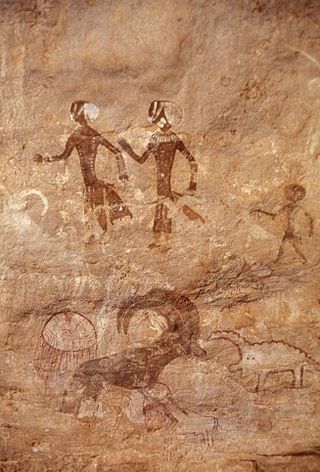
The prehistory of West Africa spans from the earliest human presence in the region until the emergence of the Iron Age in West Africa. West African populations were considerably mobile and interacted with one another throughout the population history of West Africa. Acheulean tool-using archaic humans may have dwelled throughout West Africa since at least between 780,000 BP and 126,000 BP. During the Pleistocene, Middle Stone Age peoples, who dwelled throughout West Africa between MIS 4 and MIS 2, were gradually replaced by incoming Late Stone Age peoples, who migrated into West Africa as an increase in humid conditions resulted in the subsequent expansion of the West African forest. West African hunter-gatherers occupied western Central Africa earlier than 32,000 BP, dwelled throughout coastal West Africa by 12,000 BP, and migrated northward between 12,000 BP and 8000 BP as far as Mali, Burkina Faso, and Mauritania.

Scarification in Africa is a major aspect of African cultures and cultural practice among African ethnic groups; the practice of scarification in Africa includes the process of making "superficial incisions on the skin using stones, glass, knives, or other tools to create meaningful pictures, words, or designs" and expresses "clan identity, status within a community, passage into adulthood, or spiritual significance."

The population history of West Africa is composed of West African populations that were considerably mobile and interacted with one another throughout the history of West Africa. Acheulean tool-using archaic humans may have dwelled throughout West Africa since at least between 780,000 BP and 126,000 BP. During the Pleistocene, Middle Stone Age peoples, who dwelled throughout West Africa between MIS 4 and MIS 2, were gradually replaced by incoming Late Stone Age peoples, who migrated into West Africa as an increase in humid conditions resulted in the subsequent expansion of the West African forest. West African hunter-gatherers occupied western Central Africa earlier than 32,000 BP, dwelled throughout coastal West Africa by 12,000 BP, and migrated northward between 12,000 BP and 8000 BP as far as Mali, Burkina Faso, and Mauritania.

The prehistory of Central Africa spans from the earliest human presence in the region until the emergence of the Iron Age in Central Africa. By at least 2,000,000 BP, Central Africa was occupied by early hominins. West African hunter-gatherers occupied western Central Africa earlier than 32,000 BP, dwelled throughout coastal West Africa by 12,000 BP, and migrated northward between 12,000 BP and 8000 BP as far as Mali, Burkina Faso, and Mauritania. Prehistoric West Africans may have diverged into distinct ancestral groups of modern West Africans and Bantu-speaking peoples in Cameroon, and, subsequently, around 5000 BP, the Bantu-speaking peoples migrated into other parts of Sub-Saharan Africa.

The prehistory of East Africa spans from the earliest human presence in the region until the emergence of the Iron Age in East Africa. Between 1,600,000 BP and 1,500,000 BP, the Homo ergaster known as Nariokotome Boy resided near Nariokotome River, Kenya. Modern humans, who left behind remains, resided at Omo Kibish in 233,000 BP. Afro-Asiatic speakers and Nilo-Saharan speakers expanded in East Africa, resulting in transformation of food systems of East Africa. Prehistoric West Africans may have diverged into distinct ancestral groups of modern West Africans and Bantu-speaking peoples in Cameroon, and, subsequently, around 5000 BP, the Bantu-speaking peoples migrated into other parts of Sub-Saharan Africa.






